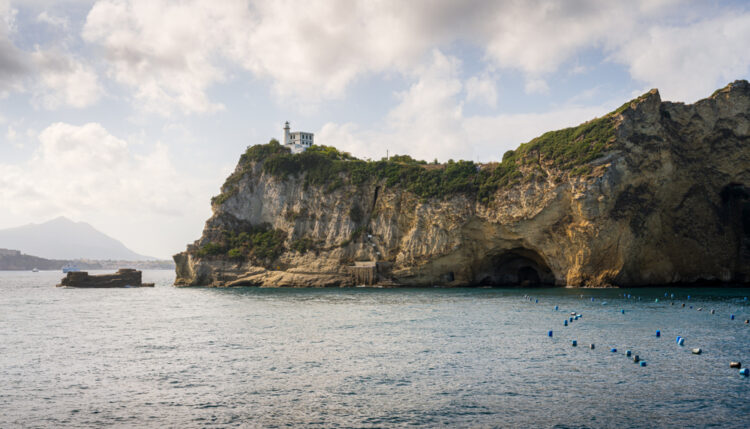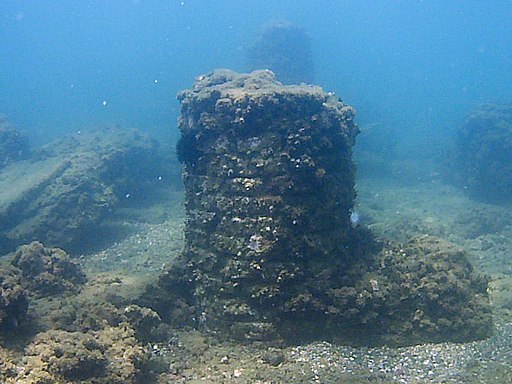In 1990 I living in Italy as part of the US contingent of NATO. Strangely, I began to hear consistent rumors of an underwater city near Naples, Italy. Local Italians told me conspiratorially that it was their own Atlantis, but few knew much else about this fabled town. The legends grew over time amongst the locals and the US military stationed just a few miles away. Was it a town built by the Romans, or maybe by the Greeks who came before them? As this region was known by the ancients to be preferred by the “Gods,” could the sunken city be something else entirely?
I was intrigued with the fabled sunken city of Italy and finally, in the days before the internet, met someone who told me where to find this hidden jewel—just off the coast of the modern-day seaside village of Baia, located in the Gulf of Pozzuoli. The port is situated by the Misenum peninsula at the north-western corner of the Gulf of Naples.
I hired a boat owned by a local fisherman one Saturday, gathered some snorkeling equipment, and went out to see what I could find on my private adventure. The day was partly cloudy, with the sun shining only periodically. We left the small pier of Baia and ventured into the waters on the fisherman’s small boat that bobbed up and down in the choppy, unsettled springtime currents.
We moved along the coast, passing the volcanic walls of yellow tufa stone of Punta Epitaffio before settling in along a straight strip of beach directly dividing the sea from Lago Lucrino or the Lucrino Lake. The fisherman excitedly told me to look down into the waters because we were above the Italian Atlantis. The waters to me were dark, and uninviting, and, frankly, I thought there must be a plate of pasta and some red wine that would be more worthy of my attention than looking into murky waters for a fabled and long-lost city.
I was steeling my frazzled nerves for a plunge into darkness when, suddenly, the clouds broke; the sun came out, and the once-dark waters were made transparent and inviting. I was stunned to find myself looking down at ancient walls and what appeared to be flooring. Excitedly, and having forgotten my previous fear, I put on my snorkeling equipment and dove into the water over the yells of the fisherman who I believed, but I could not quite hear him, was telling me to be careful.
Ruthven, CC0, via Wikimedia Commons
I touched the walls and saw that they were constructed by a type of brickwork called opus reticulatum which was certainly Roman. I next dived to the floor of the seabed, about 10 feet down, full of seagrass and curious fish and wiped it clean. To my utter astonishment, after a few minutes of going back up for air and returning to the bottom again for more cleaning, I discovered a full and massive Roman mosaic. It was white, with a black border and circle decorations that encapsulated an artistic plant. Stunned, I swam for a few hours over Roman walls and floors, through Roman columns, and around ancient statues of gods and emperors that had been partially toppled. The space I covered was no more than 100 yards, yet there was still so much more to see and discover.
I would end up going back to this underwater archeological site often over the years. In the mid-1990s, with my friend Ric Okoniewski, we started the first snorkeling tours to this underwater archeological site. It was an amazing adventure. We would start from where Ric’s sailboat (the Why Not) was moored, and enter the nearby flooded volcano of Nisida. This was one of the abodes, according to the ancient Greeks, where the cyclops Polyphemus dwelled. Other local Greek legends had it as a temporary port of the mythical Odysseus (Ulysses). After entering and swimming in an ancient volcano, we would cross the Gulf of Pozzuoli, which the ancients called the bay of Triton, son of Neptune, before eventually entering the waters around the sunken city for a dive… by now known officially as Portus Julius.
 Ruthven, CC0, via Wikimedia Commons
Ruthven, CC0, via Wikimedia Commons
As if the adventure itself of snorkeling and diving in an ancient underwater city was not exciting enough, we always made sure to have plenty of local wine, cheese, big green olives and Neapolitan bread to keep us company. We eventually moved past Portus Julius and began exploring a realm of underwater villas just off Punta Epitaffio. Inevitably, we discovered properties long hidden underneath the waves once owned by Emperor Nero and a nymphaeum constructed by Emperor Claudius. We would go on to explore, sometimes on tour and sometimes alone, various caves along the coast, many with statuary and votive offerings left behind by the Romans.



